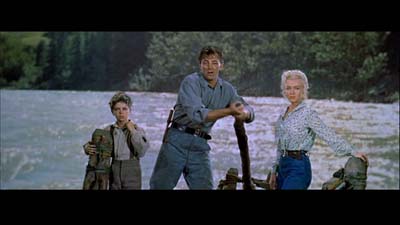Who was Otto Preminger?
When I first saw a film by Otto Preminger, I didn’t notice it. Watching River of no Return (1954), I thought it was a vehicle for Marylin Monroe, although a strange one. Something else was also going on, but at that time I couldn’t grasp it. What stayed with me though, were vivid recollections of vast landscapes, of vibrant colors, and of man, somehow lost in them. Robert Mitchum’s solitary figure cutting wood, framed by overwhelming forces of nature. A majestic river in the front, and the Rockies in the back. Mitchum stolid as a rock in the middle, while his love for Monroe becomes a force of nature itself – the river which will ultimately sweep him away.

My first real encounter with him, was through the original trailer for Anatomy of a Murder (1959). There he introduces the film himself in a courtroom, fascinating mostly with his own presence and his rhetorical articulation. What struck me most was the resemblance with the only other trailer’s I knew that took the same approach – those of Alfred Hitchcock. In a similar fashion Preminger featured as a sinister host clad in a dark suit who shows us the lifes and crimes of ordinary people, revealing what’s usually hidden beneath the surface. But while many would have dismissed this presentation as a gimmick, or a mere imitation, to me it seemed immediately clear that what we really have is an independent and strong personality that is probably on the same level with Hitchcock, possessing a unique creative vision of his own.
Preminger didn’t direct River of no Return all by himself. Some scenes were apparently by Jean Negulesco, though he wasn’t credited for it. As a studio director coming from the old Hollywood system, Preminger was at first obliged to work with what he was given. Contrary to Hitchcock who was already a famous movie director in the 30s before moving to Hollywood, Preminger had to fight his way towards independence all through the 30s and 40s, until he could emerge with his own distinct style and philosophy and the power to shoot his films the way he wanted. But in the end he achieved a comparable degree of independence through the commercial success of most of his films and the fact that he was often producing them himself. And like Hitchcock, it can be argued that he made most of his best films during the 50s, and in the end also became something of a victim of the advance of “New Hollywood”. Though he continued to make films until the end of the 70s, the films he’s best known for are from this earlier period.
Like Hitchcock he had a spellbinding presence, which he achieved at first through his outward appearance. But while Hitchcock dominated in breadth, Preminger focused on height. With 6' he was bigger than most of the people at this time. With this stature and the fact that he was originally from Austria, Hollywood did indeed use him as an actor during World War II, portraying Nazi villains most of the time. But the fact that he had had experience as a an actor himself, and was coming from a theatre background in Vienna enabled him to work with actors in a different way than they were usually used to. While in Hitchcock’s films the acting usually isn’t the strongest department (in some cases it even becomes a weak point), Preminger always gets first rate performances when he needs them, and he can stage even a conversation in a way that it doesn’t become boring. A great example is Anatomy of a murder, where the camera is often on the move, almost negating the fact that the film is a “court-room” drama that relies heavily on dialogue. In his mise-en-scene he could rival the best. Relying like Hitch on elaborate camera-movements he seems even more interested in longer takes and plan-sequences in contrast to the mastery of editing Hitchcock developed. Thus his films also seem to run along in a more moderate pace, the images having more space to breath, but without becoming boring or redundant.
While he worked in almost every genre, he said that each film tiggers its own style, its own way to be filmed. This may also be a key when trying to figure out why his name isn’t as famous today as Hitchcocks. Not imposing a singular style on his work and working on different topics didn’t help securing him an immediate “auteur” status. If you’re not easily to be pinned down, that is obviously the price you have to pay with your critics. But when the term first came to be used frequently among the “Cahiers du cinema” critics in the 1950s, Premingers name was equally present as any other studio directors’, who had achieved bigger eminence. Especially Jean-Luc Godard held him in high esteem with at least two of Premingers films being his all-time favourites (Bonjour Tristesse (1958) and Angel Face (1952)). Unfortunately, unlike his colleague Francois Truffaut, Godard didn’t embark on a lengthy interview session, and the audience often has to wonder how Preminger intended certain things. But when you have to give the answer yourself, it is probably closer to what Preminger would have wanted in the first place.

0 Comments:
Post a Comment
<< Home